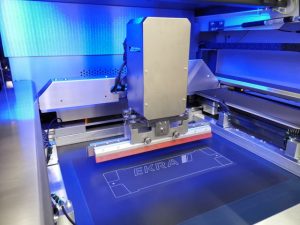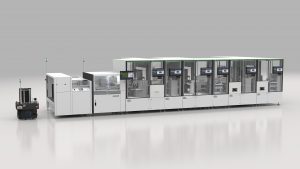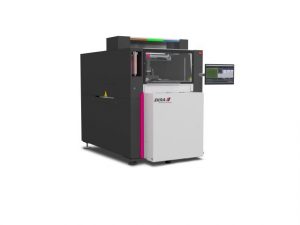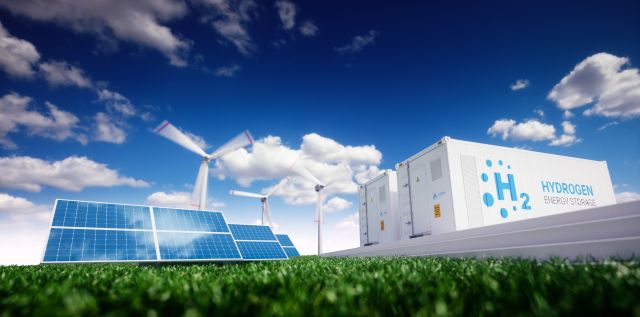The energy price shock has hit everyone, and it seems like everyone has started to think about how to escape the price spiral of fuels for heating and transportation. Also, one is anxious not to leave an unnecessarily large CO2 footprint – and so the use of hydrogen is yet again at the top of the list of available options.
Sustainability is a major topic in EKRA printing systems. While fossil materials are becoming increasingly scarce, the demand for energy is growing – worldwide. In the energy business ASYS Group is dedicated to this topic: with solar, fuel cell and battery technology the group invests in technologies that contribute to securing the future.
ASYS Group’s subsidiary, EKRA, has been following these paths for many years and the production solutions for the energy sector are predominantly developed here.
The production of fuel cells, their individual membranes and their subsequent stacking to form a high-performance fuel cell module (stack) requires specific process know-how. Individual process steps are linked to form a high-performance overall concept. ASYS Group combines its expertise as an established supplier for production automation and EKRAs printing process-specific expertise with reliability and precision.

EKRA is, among other things, an expert for high-precision printing of different, very thin and fragile substrates. These requirements are also found in the membranes of fuel cells.
Fuel cells consist of membrane electrode assemblies (MEA) and bipolar plates that are combined in stacks. These are printed with glass-, glass ceramic- or metal-based pastes and stacked on top of each other in the final process step. The printed pastes seal the individual layers of the stack to each other.
The Hycon screen printing systems for the high-end range are the machines of choice here. There are very interesting new developments which are, for example, influencing the fuel cell production:
The XH series screen printing machines have now been equipped with a paste flood system. After the screen has been flooded this area is optically scanned. Based on the gray values, one can see whether the screen is completely flooded or not. The inspection takes place directly in the machine.

The Hycon devision has also devised a process that enables the long and narrow formats of bipolar plates to be printed efficiently. This is the HYCON XH4 MultiLane.
The HYCON XH4 MultiLane enables a continuous printing process with ideal cycle times for long substrates. This means that printing can be „endless“, so to speak, with the doctor blade moving permanently.
It is a multi-track screen printer with asynchronous transport. Printing is done with a single screen which contains several print images. The individual tracks can print substrates independently and asynchronously, which means while the doctor blade is still in motion, the system is loaded with a new substrate. The screen is dynamically aligned to the substrate. The HYCON XH4 MultiLane thus achieves an interlocking process flow of transport and printing. This means maximum throughput with the shortest cycle time. Another highlight: the system is consistently designed for reel-to-reel applications. All printer movements are carried out by the upper part of the system, so endless films can be processed quickly and precisely. The XH4 MultiLane can therefore be used for various line solutions.

High throughput production fuel cell
Bipolar plates are functional components of solid oxide fuel cells. In the structure of the stack, printed pastes based on glass, glass ceramics or metals or metals seal the individual layers from each other. The high abrasiveness of these particles require fine and reproducible adjustment of the printing parameters. The motorized AutoHead, that can be integrated into the HYCON XH4 MultiLane, automates this task and thus increases the process reliability and the longevity of the doctor blade and screen. The cycle time plays a decisive role for cost efficiency in the production of bipolar plates. For this reason, several plates (usually three) are processed parallel in the patented MultiLane system printing line. The next bipolar plates in line are ready and recognized while the current one is still being printed. After they went through the drying oven, they are turned over and temporarily stored as a stack or directly transferred to a second printer for reverse-side printing.
Reel to reel as well as endless filmtracks
The printing of flexible circuits on a film basis places particular demands on the processing machines. With increasing miniaturization, precise optical alignment of the printed layers to each other becomes necessary. The XH4 Reel to Reel camera systems process transparent and reflective foils as well as printed alignment marks made of glossy or semi-transparent paste. Even the fixation of the foil substrates, which are thinner and larger than in conventional electronics production on ceramic or printed circuit board, is specially designed in the XH4 Reel to Reel. The alignment of the printed image to the foil, in the form of a screen adjustment, ensures that the foils are only experiencing the lowest possible stress and that they are processed flat. The fast and reliable transport of continuous film tracks through a complete line solution enables high throughputs for cost-effective high-volume production.

Medium-format single substrates
An even application of functional pastes in the screen-printing process is the main task in so-called thick-film applications. Driven by new market requirements, substrate sizes are increasingly being processed in medium format. Glass plates, metal sheets, ceramics or composite materials of up to 600 mm in width and length are to be coated in a structured manner. In the single-track configuration, the HYCON XH4 also transports abrasive substrates of this size reliably. The challenge while printing: A uniform coat thickness application with tolerances in the micrometer range on a large area. For this purpose, the screen-printing system uses screens with a frame format of up to 1200 x 1200 mm and adjusts them with high precision in all three dimensions relative to the substrate.
Renewable energies
Back to renewable energies: EKRA also records successful projects in the solar sector. ASYS offers the fastest solar line with a cycle time of only one second. This AIRON metallization-line is successfully used by customers and the demand for the ASYS solution is very high. The success in the solar area, as well as the new developments in the printer technology, are also driving developments in the electronics sector.

The new SERIO 4000 wins over the market
The SERIO 4000, which was introduced last year, is now in high demand. SERIO 4000 is the proven all around printing system by EKRA. Market requirements are changing, and the SERIO 4000 continues to develop. The new system is based on the experience gained from the scalable SERIO platform and has been further developed with new technology.
The clear and very concise design and structure have been retained and the accessibility has been improved once again. The design of the print head, for example, has been optimized, enabling higher accuracy. The printhead can be used for both fine-pitch and StepStencil applications. It is pneumatically controlled, maintains the pressure of the doctor blade and compensates deviations.
Back-to-Back increases throughput
Just under a year after the launch of the SERIO 4000, the revised Back-to-Back version of the machine is available. The machine is ideal for the use in double-track lines or confined spaces.
The Serio series is distinguished by its scalability. The customer can compile his machine from a wide range of options. The machines are assembled, commissioned and tested in Bönnigheim.
From the large number of available options, currently more than 180 – meaning that several tens of thousands of combinations and configurations of the printer are possible – several are increasingly high in demand.
In addition to the perennial favorites, such as paste height control and paste dispenser, the setup control is becoming a must. Many customers rely on the convenience of RFID technology for this issue.

A close up on machine details: RFID setup control
Thanks to RFID technology, setup control can be started with the push of one button. The process becomes faster, easier and safer. With this solution EKRA is laying the foundation for machine-material communication and thus for the next step: when machines make decisions independently.
Many machines are equipped with manual scanners. This means that each component has to be set up and recorded manually by the operator. In addition to that, there is also a specific order for the setup of the machine so that the set-up control is possible at all. EKRA now simplifies this process using RFID technology. The set-up components, such as doctor blades or print nests, are equipped with RFID tags. This means that the data can be read even when the hood is closed. All components are read out and compared with the loaded production program – if everything is correct, production can start immediately. The set-up control is automatic and simple and thus errors are effectively avoided. The RFID communication is carried out in a way that only the tags that are in the process area are detected. The flexibility of the system still allows the use of 1- or 2D code.
Introducing automated meassures
Set-up control with RFID synchronizes the flow of materials and information, by giving elements a certain intelligence. The communication between components and machines enables not only the identification during setup, but also the exchange of data for further traceability aspects. Thus, the system can trace, for example, how many print cycles a doctor blade has already been through and can indicate the need for replacement before quality degradation occurs.
SERIO 6000 scores with autonomy in stages
For the ASYS Group, autonomous operation is defined by reducing the use of operators to an absolute minimum. Analyses show that most customers lose efficiency during job changes. This is because the operator must be at the right place on the line at the right time to make the changeover. Otherwise, the line is unnecessarily interrupted. With this problem in mind the autonomous printer SERIO 6000 was developed.

The SERIO 6000 follows the mission „Scalable to Infinity“: the system can be individually expanded with options and features, already in the initial configuration or also subsequently if changed production processes are required. This is also the case with the autonomous options. The customer can choose if he would like to use up to 9 cartridges and an automatic cartridge change, in combination with the electric dispensing system. Or whether the entire aisle, for example the change of stencil, doctor blade and support, is carried out autonomously. The operator’s workload is reduced, and the efficiency of the line is increased. These functionalities, the scalability, was already able to convince in some benchmarks.
Sustainable resources across all product groups
In the entire manufacturing process and at every site ASYS Group pays attention to a responsible use of resources through an effective resource management. The conversion to a climate-neutral production chain is being strived for. For several years now, electricity has been generated from solar energy. EKRA printing systems are mainly produced in Germany, directly at the Bönnigheim site. Suppliers are also mainly chosen from Germany in order to create the shortest possible supply chains. The systems are very durable and if a machine is replaced, the company offers to take back the old machine.


